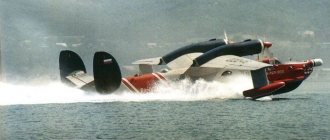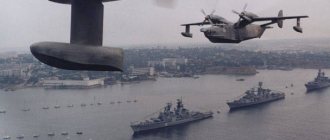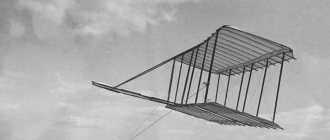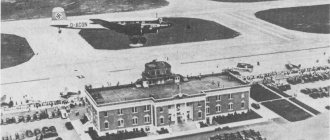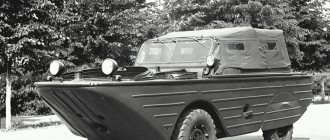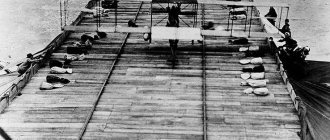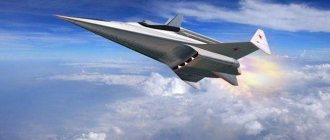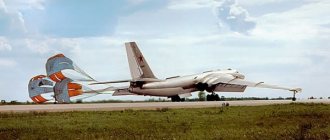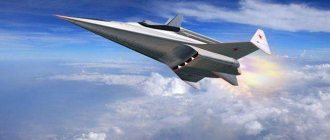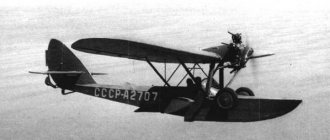The amphibious aircraft La 8 is a representative of Russian small aviation or, as it is also called “ultralight aviation,” which, before the collapse of the Union, was the link between remote regions and the centers.
All aircraft that were under state control have fallen into oblivion over the past twenty years. However, this industry is beginning to be developed by private companies that have unique designs for ultra-light aircraft. Today, the economy is developing an industry for the production of small aircraft.
The history of the glider
The first non-motorized flying vehicles appeared in the early years of the 19th century. Attempts to replicate the flight of birds have been made by people more than once. The shape of the structures resembled the silhouette of birds. However, none of the attempts to stay in the sky were successful.
The sky or the “fifth ocean” has always attracted people, so the success of Mozhaisky, who built the first aircraft with a steam engine that could take off with a person on board, determined the future of aviation.
The aircraft was a design with a wing length of almost 24 meters and a fuselage of 15 meters. Mozhaisky called the device he created an “aeronautical projectile.” Alexander Mozhaisky was unable to complete what he started, but thanks to his invention a step was taken in the history of the development of aeronautics.
Using the experience of their predecessors, inventors in all parts of the world were looking for an opportunity to look at the earth from a bird's eye view.
American inventors the Wright brothers were able to pilot an aircraft lifted into the air using an engine fueled by gasoline. The device had no resemblance to current designs, but it provided a confident path to the future exploration of the sky by man.
Aeronautics, at the dawn of its development, according to contemporaries, was a complex, difficult and unsafe activity. According to the notes of the first testers, the flights were characterized by low comfort, since the fuel system and oil supply system had not been worked out.
But the device could take off, the pilot could pilot it, however, due to the lack of a braking system, the pilot could only leave the car by jumping out of it while it was moving.
The next step in aeronautics was Sikorsky's inventions, which brought him worldwide fame. A pioneer in the history of aircraft with rigidly fixed wings, he created airplanes for the Russian army, which took first place in all competitions.
Sikorsky's flying designs formed the basis of modern military aviation. Along with Sikorsky, other aviation designers directed their knowledge and efforts to conquer heights, speed and flight range.
Ultralight aircraft occupy a special position among many aircraft. For a long time, practically no attention was paid to her. Interest in her is gradually returning.
Especially in recent years, when new technologies, materials, lighter, but more powerful and economical engines began to be introduced into the aircraft industry.
Description
The Bombardier Q400 is, without exaggeration, the world's most advanced twin-engine turboprop aircraft. It entered service in 2000. By this time, aircraft of this model had transported about 400 million passengers around the world. By the way, the aircraft has one of the highest levels of reliability in the history of aviation.
Photo of the Bombardier Q400 impresses with the grace of its lines and harmonious proportions of the car. The interior is comfortable, with two rows of ergonomic chairs with headrests installed on each side. The signature features of the Dash-8-400 are efficiency, low environmental impact and high acoustic comfort for passengers.
La-8 ultra-light aviation representative
The La 8 aircraft has the “amphibious” category, that is, it can take off and land on the surface of the water. The developer of the device is Russian, located in the Samara region. This research and production association is in charge of the entire scope of development, manufacturing, testing and sales of small aircraft.
The future flying boat seaplane received the index LA-8. The International Aviation and Space Salon in 2003 highly praised the ultra-light aircraft LA-8 with the “amphibious” category.
This meant that the aircraft was competitive not only in the domestic but also in the foreign market.
The company began serial production of the amphibian after completing the entire test program.
The multi-purpose Russian amphibian was designed to operate in all regions of the country, and was also planned for export.
However, for some reason, the perfect aircraft has few customers. The designers do not stop there; customers can be offered several options for amphibious aircraft.
Options [edit]
LA-8C Basic version is powered by two 175 kW (235 hp) LOM Praha M-337C-AV01 engines. LA-8C-RS Long-range variant of the LA-8C with two 175 kW (235 hp) LOM Praha M-337C-AV01 engines. LA-8L Variant with two 175 kW (235 hp) Lycoming IO-540B4B5 engines. LA-8L-RS Extended version of the LA-8L with two 175 kW (235 hp) Lycoming IO-540B4B5 engines. LA-8HC Flying boat / seaplane / ski based on LA-8S. LA-8HL Flying boat / seaplane / skis based on the LA-8L. LA-8LDM Option with high technical characteristics. LA-8FF Fire extinguishing option.
Flight characteristics of the LA-8 amphibian
The LA-8 ultralight aircraft, created by NPO AeroVolga, is designed to fly with a total of 8 people on board. That is, in addition to one or two pilots, six to seven passengers board and fly.
The seaplane can accept cargo weighing no more than 700 kg, provided that its dimensions correspond to the dimensions of the hatches.
The possibility of designing a vessel of ultra-light construction today is based on the use of materials of particular strength, but with a low specific weight. In addition, designers designing a seaplane incorporate modern, but freely available, instruments and equipment into the design of the device to ensure navigation and piloting.
The amphibian project provides two control options: single and dual.
For dual control of the aircraft, double sets of basic systems and devices are installed in the cockpit, designed to activate the controls and adjust the flight mode. These include: elevator, control rudder, ailerons, adjustable stabilizer.
The design of the device, in addition to the main ones, includes additional control elements: flaps, slats, spoilers, this is the so-called wing mechanization.
Dual controls are designed for flights in difficult meteorological and natural conditions.
Such a complex is installed in an amphibian at the request of the customer.
The mass of a seaplane prepared for flight, with the mandatory set of equipment that ensures the operation of the device on water and land, is 1560 kg.
The set includes:
- Anchor;
- Towing mooring and anchor ropes on land and sea;
- Hand tool gaff;
- Emergency rescue devices and instruments.
All versions of the amphibious aircraft have a single take-off weight of 2720 kg.
The aircraft is designed for use in all regions, with any climatic conditions.
Its design allows for work on any surface:
- Priming;
- Asphalt;
- Concrete;
- Freshwater and salt water bodies
- Ice;
- Snow cover.
The seaplane projection allows the use of an amphibian at sea if the wave height does not exceed 60 cm.
For a seaplane, a runway length of about 400 m is sufficient. It is capable of taking off and landing in mountainous areas at an altitude of approximately 1500 m, for piston engines. For amphibians with a turbo engine, operation at an altitude of 2500 meters is possible.
The existing Rules for Instrument Flights allow a seaplane to be equipped with radio communication equipment and sets of control systems intended for piloting and navigation.
The design of the device has a heating and ventilation system for the passenger compartment and pilots' compartment.
The maximum distance that an aircraft can cover without intermediate landings (maximum flight range) is 1200 km.
The maximum permissible load is 740 kg.
The cruising speed according to the project is 200 km/h.
The highest possible flight altitude is 4000 meters.
The seaplane can be equipped with two piston engines with a power of 310 l/s or turbine engines with a power of 300 l/s.
NPO AeroVolga provides for the provision of a choice of aircraft configuration, which is stipulated when drawing up an agreement for the production of an amphibious aircraft.
Nnn mon "YUSHPNbNKTSYU", OPEDOPHЪRKHE, GYUMKHLYUCHYEYE PYUGPYUANRYNI KH OPNHGBNDYARBNL YYULNKERNB-YULTKHAKHI, ASHKN SVPEFDEMN B 2002 TsNDS. b YNMYARPSYRNPYAYNL ACHPN mon "YUSHPNbNKTSYU" RPSDRYA YAOEZHHYUKHYARSH, KHLECHYKHE ANKENI NOSHR PUANRSH B YUBKHYUZHNMMNI OPNLSHKEMNYARH, BSHOSYAYMKHYH lNYAYNBYAYNTSN H YSIASHYE BYAYNTSN (yaYULYUPYAYNTSN) YUBKHYUZHNMMSHU bsgNB. oEPBSHHLH SHYAOEPHLEMRYUKEMSHLH KERYUREKEMSHLH YOOYUPYURYULH, PYUGPYUANRYUMMSHLH KHGTSNRNBKEMMSHLH MU OPEDOPPHYRKHKH, YARYUKH YAYULNKERSH k-6 X k-6l. nMH ASHKH HYAOSHRYUMSH X ONDRBEPDHKH GYUBKEMMSHE KERMN-REUMHVEYAYHE UYUPYYREPHYARKHYKH. mu OPNUNDHBYEL B TSNPNDE fSYNBYAYNL LEFDSMYUPNDMNL YUBKHYUZHNMMN-YNYALHVEYAYNL YUKNME ONJBKEMHE OPNRNRKHOYU k-6l BSGBYUKN MEONDDEKEMSHI KHMREPEYA YAN YARNPNMSH LMNCKHU Ts NYAREI H ETSN SVYUYARMKHYNB. YaYULNKER-YULTHAKH OPHASHK RSDU, OPENDNKEB 1 350 YL OSRKH I NDMNI OPNLEFSRNVMNI ONYAUDYNI B mHFMEL mNBTSNPNDE.b YNMZHE 2002 TSNDYU I ONEBKEMKHEL YARPURETSKHVEYAYNTSN KHMBEYARNPYU ASHKN OPKHMIRN PEYEMKHE N OPNEIRKHPNBYUMKHE X OPNKHGBNDYARBE ANKEY YANBEPYEMNTSN KERYUREKEMNTSN YOOYUPYURYU. aSHKH NOPEDEKEMSH RUYRKHYN-REUMHVEYAYHE UYUPYYREPHYARKHYH YEPKHIMNI LYUHMSH, ONKSVKHBYEI KHMDEYA kyu-8
. xDE YANGDYUMH YYULNKERYU OPKHMYUDKEFHR OPEDAEDYUREKCH YANBERYU DHPEYRNPNNB nnn mon "YUSHPNbNKTSYU" yuKYUTHMNBS ya.b. nM - KERVKHY-KCHAHREKE, KERYUK MU LMNTSKHU RHOYUU YAYULNKERNB X BEPRNKERNB B pNYAYAHH X DPSTSKHU YARPYUMYUU X GMYUER ONRPEAKHREKEYAYKHI PSHMNY YANBPELEMMNI YUBKHYUZHHH NAYETSN MYUGMYUVEMH. ShchRYU LYUHMYU GYUDSLUMYU YUY YNMYSPEMRNYAONYANAMYU ME RNKEIN MU BMSRPEMMEL, MN, B OEPBSCH NVEPEDE, MU BMEMEL PSHMYE.
b 2003 TsNDS OPNEIR kyu-8 ASHK OPEDYARYUBKEM MU leFDSMYUPNDMNL YUBKHYUZHNMMN-YNYALKHVEYAYNL YAYUKNME “lyuya-2003” X ONKSVHK BSHIANISCH NZHEMYS YAOEZHYUKHYARNB. yATEPU OPHLEMEMKH YAYULNKERYU kyu-8 DNBNKEMN LHPNYU: ShRN OEPEBNGYU OYUYAYUFHPNB X TsPSGNB, NYUGYUMKHE LEDKHZHHMAYNI ONLNYH B RPSDMNDNYARSOMSHU PYYINMYUU, OYURPSKHPNBYUMKHE CPYU MHZH, NOEYURHBMSHE DEIYARBKH OPH VPEGBSHVYUIMSHU YAHRSYUZHHU, KEYANNUPUMMYU DE'REKEMNYARE, RSPHGL KH PUGBKEVEMKH, YU RUYFE RPEMKHPPNBNVMSHE ONKERSH. kyu-8 PYYAYAVHRYUM MU 8 VEKNBEY, BYKCHVYU OHKNRYU. yaYULNKER kyu-8, OPHYAONYANAKEM Y BGKERS X ONYYUDYE I BNDSH X YASKH. dYUKEMNYARE ONKERU YANYARYUBKYER ANKEE 1000 YHKNLERPNB. YaYULNKER NYAMYUYEM DBSL DBKHTSUREKLKH VEYAYNTSN OPNKHGBNDYARBU, RNOKKHBN - YUBRNLNAKHKEMSHI AEMGKHM.
YaYULNK╦R√YULTHAKHYU√8 OPEDMYUGMYUVEM DK OEPEBNGYH OYUYAYUFHPNB H TsPSGNB, BSHONKMEMHЪ OYURPSKEMSHU, YAYUMHRYUPMSHU,ONHYAINBSHU H YAOYUYUREKEMSHU PUANR, DKЪ NYUGYUMH LEDKHZHHMAYNI ONLNYH B RPSDMNDNYARSOMSHU PUINMYUU H DPSTSKHU BHDNB PUANR, YU RUYFE DK BSHONKMEMHY SVEAAMN-RPEMKHPPNBNVMSHU, YAKSFEAMSHU H RSPKHYARAYN-PUGBKEYUREKEMSHU ONKERNB MYUD GELMNI KH BNDMNI ONBEPUMNYARECH ON OPYUBHKYUL BHGSYUKEMNTSN ONK╦RYU. dKЪ BGK╦RYU X ONYYUDYKH LNTsSR HYAONKEGNBUREYA SVYUYARYKH TSPSMRYU, YUSCHPNDPNLSH I HYAYSYAYARBEMMSHL ONYPSHRHEL, BNDMYU ONBEPUMNYARE, YANNRBERYARBSCHYKHE RPEANBUMHOL D YUMMNI HMYARPSYZHHH. b OYAYAYUFHPYAYNL BYUPKHUMRE VHYAKN LEYAR ME ANKEE BNYAELH, BYKCHVYU OHKNRYU.
YaYULNK╦R kyu√8 OPEDYARYUBKYER YANANI YABNANDMNMEYASYKHI LNMNOKYUM I BEPUMHHL PUYAONKNFEMHEL YPSHKYU, YKYUYAYAHVEYAYHL r-NAPUGMSHL NOPEPEMHEL X RP╦UYARNEVMSHL YUYAYAH I OEPEDME AND NONPNI. YaYULNK╦R YAMYUAF╦M DBSL YAHKNBSHLH SYARYUMNBYULH (YUBKHYUZHNMMSHE DBKHTSUREKH l √ 337 yu OPNKHGBNDYARBU VEYAYNI PEYAOSAKHYKH) LMNNYARECH 210 K.YA. YUFDUYU.
OPEDONKYUTSUERYA SCHYAOXYURYUZHH YAYULNK╦RYU B PNYAYAHH, YARPYUMYUU ee, chTsN-bNYARNVMNI YUGHH, AKKHFMETSN bNYARNYU KH KYURKHMYAYNI yuLEPHYH MY BYAEU KBNRYUU.
cru:
| lNDHTHYUZHH | kyu-8 |
| pYUGLUU YPSHKYU, L | 13.08 |
| dKKhMYu, L | 11.10 |
| bSHYANRYU, L | 3.40 |
| OKNYYUDE YPSHKYU, L2 | 18.60 |
| I love it, JC | |
| OSYARNCN | |
| LYUYAHLYUKEMYU BGKERMYU | 2300 |
| RNOKHBU | 380 |
| RHO DBKHTSUREK | 2 od Lom Praga l337ya |
| lnymnyare, K.Ya. | 2 U 250 |
| LYUYAKHLYUKEMYU YAYNPNYARE, YL/V | 260 |
| yPEIYEPYAYU YAYNPNYARE, YL/V | 220 |
| oPUYRHVEYAYU DUKEMNYARE, YL | 1200 |
| oPUYIRKHVEYAYKHI ONRNNKNY, L | 3000 |
| ShYKHOYUF, VEK | 1-2 |
| ONKEGMYU MYUTSPSGYU: | DN 7 OYYAYUFKHPNB KHKH 739 YC TsPSGYU |
| bottom. KhMTNPLYUZHKH: |
| tNRNCPYUTHH: | kyu-8 (c) hTSNPE yNKNYNKNB |
| kyu-8 (c) yaEPCEI pJAZHEB | |
| kyu-8 (c) Danner Møller Poulsen | |
| oYAYAYUFHPYAYU YYUAKHMYU kyu-8 (c) YUSHPNbNKTSYU | |
| yYUAHMYU OHKNRYu kyu-8 (c) yaEPCEI pJAZHEB |
| YaOHYANY HYARNVMKHYNB: |
| mon yuSHPNbNKTSYu. YaYULNKER-YULTHAKH kyu-8 yuSCHPNyaYULYUPYU. bNYAELHLEYARMSHI TSKHDPNYULNKER-YULTHAKH kyu-8 Russianplanes.net. YuSHPNbNKTSYu kyu-8 |
sTSNKNY MEAYU. 2019
Design of an ultra-light amphibious aircraft
The LA-8 amphibious aircraft is a high-wing aircraft by design, equipped with two engines.
The seaplane is painted with American-made white paints. Additionally, the surface of the seaplane is treated with polyurethane paint. It protects the applied paint and inscriptions from damage and increases the protection of the material from which the body and wings of the aircraft are made from exposure to precipitation and sunlight.
Two fuel tanks are built into the wing structure of the aircraft, and another additional fuel tank is located in the cabin. The capacity of each tank is 455 liters.
On the lower surface of the aircraft wing there are nodes designed for mooring an amphibian, both on land and on water. There is one mooring point each in the bow and stern parts of the hull. The amphibian's entrance hatch has cleats for mooring the aircraft. Their design can be stably mounted on the body or retracted inside the aircraft skin.
The designers have provided for the possibility of moving the aircraft with a crane; for this purpose, four hinges are equipped in the upper part of the hull.
There is a standard socket on board the aircraft, with the help of which technicians can connect the amphibian located at the airfield to the airfield power supply. This operation ensures that the engines start and the aircraft's battery is charged.
The amphibian wings are equipped with the following navigation devices:
- Taxiing and landing block lights. An LED block headlight is installed in the left wing, and a dual xenon landing light is located in the right wing;
- Navigation lights are mounted on the wing tip;
- The rear part of the fuselage is equipped with a rear light and a flashing light, and a parking light is built into the fin tip. It turns on when the aircraft is on the water;
- The chassis of an ultra-light vessel have;
- Three-legged design with a high stand;
- The chassis is made of a special alloy that is non-corrosive in salt water;
- Tire material that has a special protective layer that is not destroyed by mechanical and chemical influences;
- The landing gear is designed according to special parameters that ensure the aircraft can land on an unprepared landing site;
- The chassis is released and retracted by a hydraulic drive. In the event of a malfunction of this design, emergency release is provided using mechanical rods;
- To indicate the position of the landing gear of a seaplane landing on the water with the devices retracted, a special system has been developed: the retracted position of the support system is recorded on the indicator in bright blue, the landing gear in the working, extended position is indicated in yellow, panoramic mirrors on the floats expand visual control;
- The wheel suspension is equipped with gas-liquid shock absorbers.
The control of a seaplane when it moves on the water surface is based on the difference in thrust forces between the engines; separate braking of the wheels regulates the movement of the aircraft on the hard surface of the earth:
- Braking is carried out by a hydraulic system on the brake pedals;
- In addition to this braking method, the design of the device has a parking brake system, with which you can brake the main wheels. The parking braking system can hold the vehicle in place for quite a long time;
- The La-8 seaplane can be controlled by one or two pilots. Its design provides two workplaces: left and right. Each of them has a complete control set - a steering wheel and pedals;
- The helm support has a built-in safety pin, marked in bright red. This element locks the elevators and ailerons while parked at the airfield;
- A remote control is located on the central instrument panel, with the help of which the autopilot device is launched and controlled. There is an emergency shutdown button for the autopilot on the helm;
- The central console, located between the pilots' workstations, is designed to control engines, trim tabs, and propellers. The engine control panel is equipped with an automatic lock that prevents the possibility of turning on reverse if the vehicle speed exceeds 100 km/h at an engine speed of 1,000 rpm;
- The aircraft control system has control levers, with their help the forward/reverse thrust is controlled; The flaps are controlled by an electric drive; their position is controlled visually or by an indicator. The pilots' work comfort is determined by a comfortable seat position, which is determined by;
- System for moving seats in the longitudinal direction;
- Adjustment of their design according to the height of the pilot (160-200 cm), the presence of handrails that ensure the convenience of performing this procedure;
- The presence of automatic cushion inserts in the design of the seats.
The amphibious aircraft is equipped with an entrance hatch, which is located at the rear of the fuselage. This hatch is used for boarding a seaplane on land and on water.
This arrangement of the entrance hatch allows for the loading of long cargo and the transportation of patients placed on special stretchers.
Pistol FN Browning 1910 / Browning 1910/22
FN Browning 1910 pistol
FN Browning 1922 pistol
The Model 1910 occupied the niche of a compact personal weapon for concealed carry for a long time. The main difference between this pistol and previous Browning designs lies, first of all, in the layout. The return spring is placed on the barrel, due to which the dimensions of the bolt-casing and the weapon as a whole have been significantly reduced. The disadvantage of this scheme is that the return spring overheats during prolonged and high-speed shooting, and it loses its mechanical qualities, as a result of which the bolt-casing may not reach the rearmost position. The Model 1910 was originally chambered in 7.65mm Browning. Since 1912, the production of pistols chambered for the 9mm Short cartridge began.
In 1922, by order of the Kingdom of Serbs, Croats and Slovenes, a new version of the Model 1910 was released with an extended barrel and a handle that could accommodate a larger capacity magazine, called the FN Browning 1922. Its magazine held 9 rounds of 7.65mm Browning or 8 rounds of 9mm Short. The automation of both models works according to the scheme of using recoil with a free shutter. The return spring is secured with a bushing. The trigger mechanism is striker type, single action. The pistol is equipped with three safeties - flag, automatic lever and magazine. The single-stack magazine is held in place by a latch located at the bottom of the handle. The sighting devices of the 1910 model are a longitudinal groove running along the upper edge of the shutter-casing, inside of which a semicircular front sight is located at the front. Model 1910/22 is distinguished by a protruding rear sight with the possibility of making lateral adjustments and a front sight that is part of the barrel sleeve.
Over the course of many years of operation, the Brownings 1910 and 1910/22 proved to be very reliable, comfortable, durable and quite efficient. These pistols were both personal self-defense weapons for citizens and service weapons in the armies and police of various countries around the world. The Model 1910 was also a terrorist weapon. On June 28, 1914, from Browning 1910, number 19074, a Serbian terrorist killed the Austrian heir to the throne, Archduke Franz Ferdinand, and his wife Sophia Chotek in Sarajevo, which served as a formal reason for the outbreak of the First World War.
Browning 1910/22 in 1920 - 1940 was in service with the armies of Belgium, Yugoslavia and the Netherlands, although they were most widely used by the police. During World War II, compact Brownings were used by resistance units. But in greater numbers, Browning Model 1910/22 were used by the German army as weapons of a limited standard under the designation Pistole 626(b) in 7.65 mm caliber and Pistole 641(b) in 9 mm caliber. During the occupation of Belgium, about 363,000 of these pistols were manufactured. In the future, they became the prototypes of pocket and police models of the Walter company, such as the Model 8, as well as PP and PPK, which in turn became the basis for other equally famous pistols.
The purpose of an amphibious aircraft
The widespread use of the amphibian is determined by its design. Specialists from NPO AeroVolga have developed an almost instantaneous transformation of the passenger version of the aircraft into a cargo one. For this purpose, power rails are installed, equipped with a device for securing loads. The aircraft cabin is designed to transport cargo no longer than 4 meters.
If necessary, the aircraft can be converted into an ambulance transport for transporting patients.
Arranging two beds and one place for accompanying personnel will take no more than half an hour.
The La-8 ultralight aircraft can continue to fly over long distances; in addition, the ability to land on water and a short runway allow it to be used:
- To control the composition of water on the surface and depth of reservoirs;
- Echo sounders and sonars allow you to explore the bottom of a water basin;
- The device can be used in winter, for this purpose the installation of non-retractable ski chassis is provided. This equipment of the vehicle allows it to be operated on prepared snow-covered runways and on virgin land;
Be-12
This modification has its own name “Chaika” and is a long-liver of the navy. Its development and placement on combat duty was dictated by the emergence of a nuclear submarine fleet. The Chaika made its first flight in 1960, and 3 years later it went on combat duty.
Technical capabilities allowed the vehicle to make loitering flights at a distance of up to 600 km from the base at a speed of about 320 km/h.
“Chaika” is the first amphibious model equipped with a turboprop engine (there were 2 of them). But in addition to this, the possibility of saving the car in case of failure of both was provided. In such a situation, spare gas turbine engines were turned on.
The vehicle had good military weapons: anti-submarine torpedoes and depth charges. However, its main purpose was still search and reconnaissance. The crew was faced with the task of detecting an enemy boat. For this purpose, a radar installation was mounted in the bow compartment, and a device recording magnetic anomalies was installed in the tail section. The list of required equipment also included a camera.
Production of the model was discontinued back in 1973, but the remaining aircraft are in use to this day. Therefore, the Be-12 is considered a long-lived amphibian.
Safety
Over the entire period of operation, the seaplane aircraft acquired the characteristics of a reliable and safe transport used in difficult situations.
The following installations and devices ensure the safety of seaplane flights:
- If one of the engines fails, the emergency situation is mitigated by the operation of the device on one power plant. At the same time, the aircraft is prevented from turning around, reducing altitude, the specified flight path is maintained, and autorotation of a failed propeller is prevented;
- The device is equipped with flight and navigation devices that ensure its operation in difficult weather conditions. The devices perform height control and visibility in poor weather conditions using highly sensitive optical cameras. The aircraft is equipped with a ground proximity warning system;
- The TAS system ensures that there is no chance of a mid-air collision with other aircraft;
- The main devices of the seaplane, on which the safety of the flight depends, are equipped with an emergency power supply device, which ensures the flight within 1 hour;
- A detector that registers a sudden loss of lift, that is, the approach of the so-called stall mode, built into the left wing of the aircraft. The critical mode alert is signaled by a pulsed red light with an accompanying signal;
- Since the aircraft is used in any climatic conditions, the design provides a heating system for components that are dangerous from icing;
- Information about the status of all systems is displayed on a special screen;
- An overview of almost the entire glider is provided by panoramic mirrors and mirrors in the glider's cabin. External mirrors on the floats have special lights for viewing in the dark;
LA-8 is a unique ultra-light vessel in which control of each individual component is carried out, and a system for warning of a possible emergency has been developed. On board the amphibian there are all modern rescue elements and warning devices provided for this type of aircraft.
Depending on the number of installed seats, the seaplane is equipped with life jackets. An axe, a fire extinguisher, a life raft for eight people, and a battery-powered floating lantern designed for long-term stay in water are required.
There are oxygen devices on board for the crew to use in case of smoke in the pilot compartment.
The structural part of the amphibian is designed to withstand the overloads that occur when falling and hitting the ground or water during a forced landing. Therefore, the powerful body of the aircraft serves as the main rescue structure for passengers and pilots.
The LA-8 amphibious aircraft made its first flight in 2004. Almost immediately after the presentation at the International Salon, manufacturers began producing a unique aircraft. Currently there are 8 units in operation.
Despite the small number of orders, the company is in full readiness to produce new aircraft. Designers continue to improve individual components of the LA-8 and can offer the customer several modifications of the amphibian, which gives hope for a long history of the aircraft with a happy ending.
Beriev – chief designer
The first success of the young designer led to the creation of the Central Design Bureau of Marine Aircraft Manufacturing (TsKB MS) under his leadership in 1934. Before his new appointment, Beriev studied the aviation industry on a six-month trip to aircraft factories in Europe and the USA. Taganrog with a powerful production base in the form of aircraft plant No. 31 was chosen as the birthplace of the new design bureau. Beriev becomes the chief designer of the plant and the head of the new Central Design Bureau. Together with Beriev, his colleagues from Moscow plant No. 39 arrive. Having strengthened the team with graduates of local universities and colleges, Beriev began improving the MBR-2 and developing new aircraft.
As the chief designer, Beriev paid great attention to team unity. He actively supported the flying club so that the design bureau and plant workers could experience the joy of flying or parachute jumping.
One day, Georgy Mikhailovich himself, flying the MBR-2 as a co-pilot, was able to land a plane with a failed engine on the water, fix the problem and return to base.
KOR-2 seaplane on the Soviet cruiser Molotov
Before the start of the Great Patriotic War, under the leadership of Beriev, a number of seaplanes were produced, including the shipborne ejection reconnaissance aircraft KOR-1 (Be-2) and KOR-2 (Be-4), which became the first in their class and were used at the front. It was the ejection direction that Beriev studied abroad. During the war, the plant and design bureau were evacuated to Omsk, then to Krasnoyarsk, where they worked on promising projects.
Notes
- Alexey Mikheev
[www.take-off.ru/pdf/09_2006.pdf By water like dry land. La-8] // Takeoff: magazine. - 2006. - No. 9. - P. 10-11. — ISSN [www.sigla.ru/table.jsp?f=8&t=3&v0=1819—1754&f=1003&t=1&v1=&f=4&t=2&v2=&f=21&t=3&v3=&f=1016&t=3&v4=&f=1016&t=3&v5 =&bf=4&b=&d=0&ys=&ye=&lng=&ft=&mt=&dt=&vol=&pt=&iss=&ps=&pe=&tr=&tro=&cc=UNION&i=1&v=tagged&s=0&ss=0&st=0&i18n=ru&rlf=&psz =20&bs=20&ce=hJfuypee8JzzufeGmImYYIpZKRJeeOeeWGJIZRrRRrdmtdeee88NJJJJpeeefTJ3peKJJ3UWWPtzzzzzzzzzzzzzzzzbzzvzzpy5zzjzzzzzzzzzzzzzzzzzzzzzzzzz zzzzztzzzzzzzbzzzzzzzzzzzzzzzzzzzzzzzzzzzzzzzzzyeyTjkDnyHzTuueKZePz9decyzzLzzzL*.c8.NzrGJJvufeeeeeJheeyzjeeeeJh*peeeeKJJJJJJJJJmjHvOJJJJJJJJfe eeieeeeSJJJJSJJJ3TeIJJJJ3..E.UEAcyhxD.eeeeeeuzzzLJJJJ5.e8JJJheeeeeeeeeeeeyeyeK3JJJJJJJJ*s7defeeeeeeeeeeeeeeeeeeeeeeeeSJJJJJJJZIJJzzz1..6LJJJJJJtJJZ4….EK*&deb ug=false 1819—1754]. [www.webcitation.org/6IPlRxhjv Archived] from the original July 27, 2013. - [www.aerosamara.com/skb/ Student Design Bureau of Samara State Aerospace University.]
- [www.aerovolga.com/ru/overview/characteristics.html La-8: Technical characteristics]. NPO AeroVolga. Retrieved July 27, 2013. [www.webcitation.org/6JIfbkDx5 Archived from the original on September 1, 2013].
